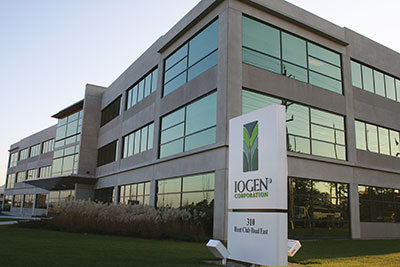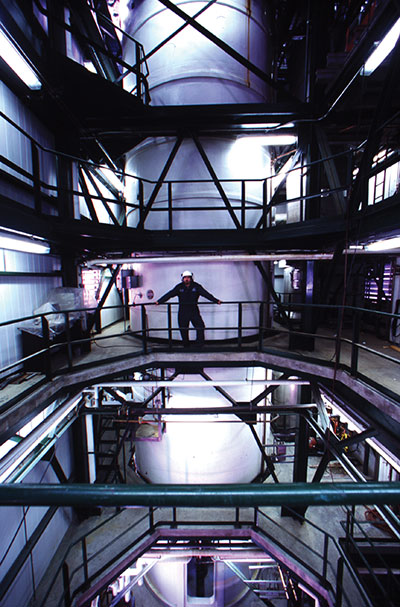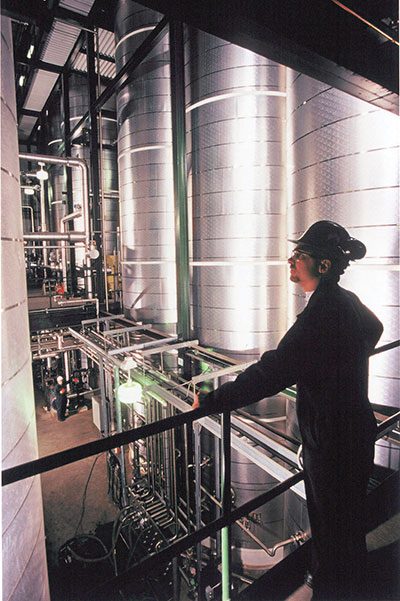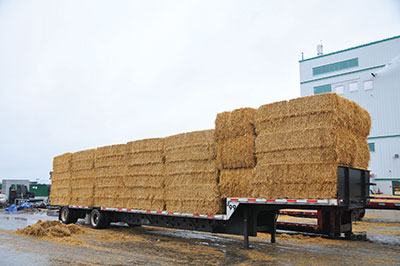
Biofuel pioneer
June 3, 2014
By
Andrew Macklin
It has been 10 years since Iogen became the first company to produce significant volumes of cellulosic ethanol using enzymatic hydrolysis processes.
It has been 10 years since Iogen became the first company to produce significant volumes of cellulosic ethanol using enzymatic hydrolysis processes. In the decade that has followed, the company has undergone an evolution that has allowed them to remain as a prominent provider of breakthrough biofuel technology.
 |
|
| In 2004, Iogen became the first company to produce significant volumes of cellulosic ethanol using enzymatic hydrolysis processes.
|
The innovation demonstrated in 2004, along with the company’s alliance with Shell, caught the attention of the fuel industry across North America, landing Iogen on the cover of The Wall Street Journal amidst the incredible buzz generated south of the border.
“In America, they were saying wow, we have the capacity to produce 100 billion gallons of cellulosic biofuel without affecting our food supply,” says Iogen CEO Brian Foody.
Over the next few years, the United States worked to develop its own policies for the use of renewable fuels. In 2007, the U.S. government released the Energy Independence and Security Act. The purpose of the bill was to reduce America’s reliance on oil and increase the production of renewable fuels. That led to the Renewable Fuel Standard mandate to produce 36 billion gallons of renewable fuel in the U.S.
The Canadian Approach
Canada took a different approach during that same time, choosing instead to focus on setting up commercial demonstration and large-scale production facilities. Sustainable Development Technology Canada set up a $500 million program that offered 40 per cent of the monies needed for the construction of first commercial facilities for Canadian biofuel producers. That program was attractive for companies like Iogen, and Iogen was one of the first to apply for the new program to move its business venture forward.
 |
|
| In November of 2013, Iogen and Raizen announced the start of construction of a commercial biomass-to-ethanol facility using Iogen’s advanced cellulosic biofuel technology.
|
The SDTC project, Foody explains, was a visionary project, as it provided an aggressive commitment to commercialization. But the program’s focus has some downfalls.
“Canada has done a very good job putting in place policies that help technology development and technology deployment,” says Foody. “The flipside is, in terms of market initiatives, there are jurisdictions in the U.S. that are ahead of Canada.”
Iogen hoped that the SDTC funding would allow them to build a full-scale operation in western Canada, and they began working on building partnerships to find the right fit for the cellulosic ethanol facility.
Up until late in 2009, it looked as though the fit would be the shuttered Domtar pulp mill in Prince Albert, Saskatchewan. But in late-November of that year, Domtar announced that it was pressing forward with plans for demolition. A few weeks later, Iogen confirmed that talks with Domtar had indeed stopped. Just nine months after that, the project was dead – Iogen was left to find a new home.
For the next few years, the company continued diligently looking for a site that would make sense for a full-scale cellulosic ethanol facility. But, once again, they were unable to come up with a site that made financial sense based on the needs of the operation.
“We ended up having to do a reset,” explains Foody. “The project we were pursuing with Shell was stopped. We had to look and say, how can we move our technology forward less expensively.”
In January of 2013, Iogen announced the sale of its enzyme business to Novozymes for $67.5 million CDN. The sale included the entirety of Iogen’s industrial enzyme business, which had been in operation since 1991. The sale allowed the company to
focus on the development of its biofuel technologies.
Iogen worked out a partnership with a Shell partner, Raizen Energia Participacoes S/A, a company that represented the merger of Cosan and Royal Dutch Shell in Brazil. In November of 2013, Iogen and Raizen announced the start of construction of a commercial biomass-to-ethanol facility using Iogen’s advanced cellulosic biofuel technology. Located adjacent to Raizen’s Costa Pinto sugarcane mill, the $100 million plant will produce 40 million litres of cellulosic ethanol, at full capacity, using sugarcane bagasse and straw.
“The Brazilian industry is bottlenecked by the high cost of creating new sugarcane plantations,” Foody explains. “We needed to look at way to get more feedstock off
the land.”
By using the waste products in the production of the ethanol, the amount of available feedstock has been increased by 40-50 per cent. That has given Raizen, the third largest Brazilian energy company, the ability to significantly increase their yield and will allow for expansion at a much lower cost.
Iogen used its extensive experience with cereal straw and corn stover to understand the differences in operation using sugarcane bagasse. After six months, Iogen was able to identify differences, troubleshoot any problems that arose, collect needed data, and make adjustments to the design to provide Raizen with a low-cost operation.
“We’re very excited to be working with a major industry player like Raízen to deliver large scale cellulosic ethanol production” says Foody. “Raizen is an incredibly dynamic partner with immense know-how and expertise in first generation ethanol production. We share a common vision for the global potential of our technology and the importance of developing a successful first project. This project with Raizen is a key step towards rolling our technology out around the world.”
Game Changer
Just two months after the announcement of the partnership, Raizen, in January of 2014, Iogen announced the development of a patented drop-in cellulosic biofuel, a game changer for the company. Iogen has already been issued two patents for this new technology.

|
|
| In January of 2014, Iogen announced the development of a patented drop-in cellulosic biofuel. The company has already been issued two patents for this new technology.
|
The process involves using the residual material from the cellulosic material that is now a waste product and turning that into biogas through anaerobic digestion or gasification. The biogas is then converted to hydrogen, making it renewable hydrogen, and then the renewable hydrogen is blended in the refining process to produce hydrogenate petrochemicals, thereby effectively creating a gasoline that contains renewable hydrogen.
The opportunity for this technology is upwards of five billion gallons of drop-in renewable fuel, and it nearly doubles the yield in the production of cellulosic biofuel.
As a result of the new development, Iogen is now actively consulting with the U.S. Environmental Protection Agency and the California Air Resources Board for approval for cellulosic LCFS and RIN credit generation.
“Biogas is produced today from landfills, wastewater treatment plants, waste digestion facilities, and farm digesters with well-proven technology,” says Foody. “We can now take biogas and make specification gasoline and diesel with renewable content using well-proven existing refining operations. It is a win for everybody.”
Iogen also noted that the technology would be used in concert with two commercial-scale ethanol projects that they are developing in the U.S. The expected result of the use of the drop-in fuel is increased overall cellulosic biofuel yields per unit of feedstock, lower water usage per unit in the production of biofuel and lower overall
capital costs.
Moving Forward
With new partnerships and product development in place, Iogen’s innovations are impacting the global biofuel market. As was the case 10 years ago, that means playing an active role in the development of the American biofuel industry. Iogen was a founding member of the Advanced Ethanol Council, and the company is continuously involved in policy discussions in Washington D.C.
 |
|
| Iogen’s use of cereal straw and corn stover for biofuel production helped the company quickly adjust to the use of sugar cane bagasse for the Raizen operation.
|
According to Foody, the huge demand for renewable fuel, and even larger interest from investors, has made the U.S. a focal point for the biofuel industry.
“Iogen is a global competitor in the development of cellulosic biofuel technologies,” says Foody. “Working in the global industry means thinking about the U.S. market”
As for Canada, “policy makers need to make a choice” about what direction they will take with the idea of introducing a renewable fuel standard or low carbon fuel standard. Foody believes the will is there to do something, but what will be done remains to be seen.
Print this page